Integrating Climate Risk in Cultural Heritage: A Critical Review of Assessment Frameworks
Abstract
1. Introduction
2. Review of Frameworks
2.1. Global Climate Frameworks
2.2. Global Cultural Heritage Frameworks
2.3. RAFMs and Components of Risk
3. Methodology
3.1. Selection Process
3.2. Analysis and Synthesis
3.3. Limitations
4. Results
4.1. RQ1: Are IPCC-Based Climate Scenarios Considered in the Hazard Component of Existing RAFMs That Apply to Cultural Heritage?
4.2. RQ2: How Are Risk Components, Particularly Exposure and Vulnerability, Defined by Different RAFMs Relative to the Context of IPCC?
4.3. RQ3: Aside from IPCC, to What Extent Are Existing RAFMs Aligned with Global Climate-Related and Disaster Risk Reduction Policy Convention Frameworks?
4.4. Typologies and Limitations of Frameworks
4.5. Best Practices and Moving Forward
5. Conclusions
Supplementary Materials
Author Contributions
Funding
Acknowledgments
Conflicts of Interest
Abbreviations
| AR4 | Fourth Assessment Report |
| AR5 | Fifth Assessment Report |
| AR6 | Sixth Assessment Report |
| CC | Climate Change |
| CH | Cultural Heritage |
| DRR | Disaster Risk Reduction |
| ICCROM | International Centre for the Study of the Preservation and Restoration of Cultural Property |
| ICOMOS | International Council on Monuments and Sites |
| IPCC | Intergovernmental Panel on Climate Change |
| PRISMA | Preferred Reporting Items for Systematic Reviews and Meta-Analyses |
| RAFMs | Risk Assessment Frameworks and Methodologies |
| RQs | Research Questions |
| SDGs | Sustainable Development Goals |
| SotA | State of the Art |
| TAR | Third Assessment Report |
| UN | United Nations |
| UNESCO | United Nations Educational, Scientific and Cultural Organization |
| WoS | Web of Science |
References
- IPCC. Summary for Policymakers. In Climate Change 2023: Synthesis Report. Contribution of Working Groups I, II and III to the Sixth Assessment Report of the Intergovernmental Panel on Climate Change; Core Writing Team, Lee, H., Romero, J., Eds.; IPCC: Geneva, Switzerland, 2023; pp. 1–34. [Google Scholar] [CrossRef]
- Magdalena, P.S. The Impact of Climate Change on Cultural Heritage; European Parliamentary Research Service: Belgium, Brussels, 2024; Available online: https://coilink.org/20.500.12592/brv1bt0 (accessed on 4 July 2025).
- Fatorić, S.; Seekamp, E. Are Cultural Heritage and Resources Threatened by Climate Change? A Systematic Literature Review. Clim. Change 2017, 142, 227–254. [Google Scholar] [CrossRef]
- Thuc, L.D.; Van Nguyen, M.; Ha Duy, K.; Nguyen Van, D. Prioritizing Barriers to the Conservation of Cultural Heritage Buildings in Adaptation to Urbanization and Climate Change. J. Clean. Prod. 2024, 473, 143529. [Google Scholar] [CrossRef]
- Mohamed Ismail, B. Policies and Strategies to Resilience Climate Changes in Heritage Sites. Int. J. Adv. Eng. Civ. Res. 2021, 1, 1–20. [Google Scholar] [CrossRef]
- Giglio, F.; Frontera, P.; Malara, A.; Armocida, F. Materials and Climate Change: A Set of Indices as the Benchmark for Climate Vulnerability and Risk Assessment for Tangible Cultural Heritage in Europe. Sustainability 2024, 16, 2067. [Google Scholar] [CrossRef]
- Estoque, R.C.; Ishtiaque, A.; Parajuli, J.; Athukorala, D.; Rabby, Y.W.; Ooba, M. Has the IPCC’s Revised Vulnerability Concept Been Well Adopted? Ambio 2023, 52, 376–389. [Google Scholar] [CrossRef]
- Klein, R.J.; Nicholls, R.J.; Mimura, N. Coastal Adaptation to Climate Change: Can the IPCC Technical Guidelines Be Applied? Mitig. Adapt. Strateg. Glob. Change 1999, 4, 239–252. [Google Scholar] [CrossRef]
- Moser, S.C.; Ekstrom, J.A. A Framework to Diagnose Barriers to Climate Change Adaptation. Proc. Natl. Acad. Sci. USA 2010, 107, 22026–22031. [Google Scholar] [CrossRef]
- Cabana, D.; Rölfer, L.; Evadzi, P.; Celliers, L. Enabling Climate Change Adaptation in Coastal Systems: A Systematic Literature Review. Earth’s Future 2023, 11, e2023EF003713. [Google Scholar] [CrossRef]
- Crowley, K.; Jackson, R.; O’connell, S.; Karunarthna, D.; Anantasari, E.; Retnowati, A.; Niemand, D. Cultural Heritage and Risk Assessments: Gaps, Challenges, and Future Research Directions for the Inclusion of Heritage within Climate Change Adaptation and Disaster Management. Clim. Resil. Sustain. 2022, 1, e45. [Google Scholar] [CrossRef]
- UNESCO Institute for Statistics (UNESCO-IS). Cultural Heritage. In UNESCO Framework for Cultural Statistics; UNESCO Institute for Statistics: Montreal, QC, Canada, 2009; pp. 1–2. [Google Scholar]
- Koudoumakis, P.; Keramitsoglou, K.; Protopapas, A.L.; Dokas, I. A General Method for Multi–Hazard Intensity Assessment for Cultural Resources: Implementation in the Region of Eastern Macedonia and Thrace, Greece. Int. J. Disaster Risk Reduct. 2024, 100, 104197. [Google Scholar] [CrossRef]
- Zin, N.M.; Ismail, F.Z. Cultural Heritage Protection from Disaster Impacts: A Review of Global Disaster Risk Reduction Frameworks. IOP Conf. Ser. Earth Environ. Sci. 2023, 1217, 012004. [Google Scholar] [CrossRef]
- Reisinger, A.; Howden, M.; Vera, C.; Garschagen, M.; Hurlbert, M.; Kreibiehl, S.; Mach, K.J.; Mintenbeck, K.; O’Neill, B.; Pathak, M.; et al. The Concept of Risk in the IPCC Sixth Assessment Report: A Summary of Cross-Working Group Discussions. Guidance for IPCC Authors; Intergovernmental Panel on Climate Change: Geneva, Switzerland, 2020; Available online: https://www.ipcc.ch/site/assets/uploads/2021/02/Risk-guidance-FINAL_15Feb2021.pdf (accessed on 4 July 2025).
- Kelman, I. Climate Change and the Sendai Framework for Disaster Risk Reduction. Int. J. Disaster Risk Sci. 2015, 6, 117–127. [Google Scholar] [CrossRef]
- Morgan, J. Paris COP 21: Power That Speaks the Truth? Globalizations 2016, 13, 943–951. [Google Scholar] [CrossRef]
- Hosagrahar, J.; Soule, J.; Girard, L.F.; Potts, A. Cultural Heritage, the UN Sustainable Development Goals, and the New Urban Agenda. BDC Boll. Cent. Calza Bini 2016, 16, 37–54. [Google Scholar]
- Niebuhr, R. The Theory and Practice of UNESCO. Int. Organ. 1950, 4, 3–11. [Google Scholar] [CrossRef]
- ICCROM. Statutes of the International Centre for the Study of the Preservation and Restoration of Cultural Property (ICCROM); ICCROM: Rome, Italy, 2013; Available online: https://www.iccrom.org/sites/default/files/2020-02/statutes_2013_eng_fre_version_9jan14.pdf (accessed on 4 July 2025).
- ICOMOS. International Charter for the Conservation and Restoration of Monuments and Sites (The Venice Charter); ICOMOS: Paris, France, 1964; Available online: https://admin.icomos.org/wp-content/uploads/2025/03/Venice_Charter_EN.pdf (accessed on 4 July 2025).
- Dastgerdi, A.S.; Sargolini, M.; Pierantoni, I. Climate Change Challenges to Existing Cultural Heritage Policy. Sustainability 2019, 11, 5227. [Google Scholar] [CrossRef]
- Pedersoli, J.L., Jr.; Antomarchi, C.; Michalski, S. A Guide to Risk Management of Cultural Heritage; ICCROM: Rome, Italy, 2016; Available online: https://www.iccrom.org/sites/default/files/Guide-to-Risk-Managment_English.pdf (accessed on 4 July 2025).
- Pavlova, I.; Fassoulas, C.; Watanabe, M.; Canet, C.; Cupa, P. UNESCO Designated Sites—Natural and Cultural Heritage Sites as Platforms for Awareness Raising. In Contributing Paper to Global Assessment Report on Disaster Risk Reduction (GAR); UNDRR: Geneva, Switzerland, 2019. [Google Scholar]
- Hambrecht, G.; Rockman, M. International Approaches to Climate Change and Cultural Heritage. Am. Antiq. 2017, 82, 627–641. [Google Scholar] [CrossRef]
- Li, M. Disaster Risk Management of Cultural Heritage: A Global Scale Analysis of Characteristics, Multiple Hazards, Lessons Learned from Historical Disasters, and Issues in Current DRR Measures in World Heritage Sites. Int. J. Disaster Risk Reduct. 2024, 110, 104633. [Google Scholar] [CrossRef]
- Sesana, E.; Gagnon, A.S.; Bertolin, C.; Hughes, J. Adapting Cultural Heritage to Climate Change Risks: Perspectives of Cultural Heritage Experts in Europe. Geosciences 2018, 8, 305. [Google Scholar] [CrossRef]
- Kohler, T.A.; Rockman, M. The IPCC: A Primer for Archaeologists. Am. Antiq. 2020, 85, 627–651. [Google Scholar] [CrossRef]
- Garcia, B.M. Integrating Culture in Post-Crisis Urban Recovery: Reflections on the Power of Cultural Heritage to Deal with Crisis. Int. J. Disaster Risk Reduct. 2021, 60, 102277. [Google Scholar] [CrossRef]
- Orr, S.A.; Richards, J.; Fatorić, S. Climate Change and Cultural Heritage: A Systematic Literature Review (2016–2020). Hist. Environ. Policy Pract. 2021, 12, 434–477. [Google Scholar] [CrossRef]
- Simpson, N.P.; Orr, S.A.; Sabour, S.; Clarke, J.; Ishizawa, M.; Feener, R.M.; Ballard, C.; Mascarenhas, P.V.; Pinho, P.; Bosson, J.-B.; et al. ICSM CHC White Paper II: Impacts, Vulnerability, and Understanding Risks of Climate Change for Culture and Heritage: Contribution of Impacts Group II to the International Co-Sponsored Meeting on Culture, Heritage and Climate Change; ICOMOS & ISCM CHC: Charenton-le-Pont, France; Paris, France, 2022; 109p, ISBN 978-2-918086-72-7. [Google Scholar]
- Taboroff, J.; Coute, P.; Orr, S.; Ali, S. The British Council Strategic Literature Review: Climate Change Impacts on Cultural Heritage; British Council: London, UK, 2023. [Google Scholar]
- De Masi, F.; Larosa, F.; Porrini, D.; Mysiak, J. Cultural Heritage and Disasters Risk: A Machine-Human Coupled Analysis. Int. J. Disaster Risk Reduct. 2021, 59, 102251. [Google Scholar] [CrossRef]
- Laohaviraphap, N.; Waroonkun, T. Integrating Artificial Intelligence and the Internet of Things in Cultural Heritage Preservation: A Systematic Review of Risk Management and Environmental Monitoring Strategies. Buildings 2024, 14, 3979. [Google Scholar] [CrossRef]
- Maldonado-Erazo, C.P.; Álvarez-García, J.; Río-Rama, M.D.L.C.D.; Durán-Sánchez, A. Scientific Mapping on the Impact of Climate Change on Cultural and Natural Heritage: A Systematic Scientometric Analysis. Land 2021, 10, 76. [Google Scholar] [CrossRef]
- Sesana, E.; Gagnon, A.S.; Ciantelli, C.; Cassar, J.; Hughes, J.J. Climate Change Impacts on Cultural Heritage: A Literature Review. WIREs Clim. Change 2021, 12, e710. [Google Scholar] [CrossRef]
- Adetunji, O.S.; MacKee, J. Frameworks for Climate Risk Management (CRM) in Cultural Heritage: A Systematic Review of the State of the Art. J. Cult. Herit. Manag. Sustain. Dev. 2023, in press. [Google Scholar] [CrossRef]
- Nguyen, K.N.; Baker, S. Climate Change and UNESCO World Heritage-Listed Cultural Properties: A Systematic Review, 2008–2021. Heritage 2023, 6, 2394–2420. [Google Scholar] [CrossRef]
- Forino, G.; MacKee, J.; von Meding, J. A Proposed Assessment Index for Climate Change-Related Risk for Cultural Heritage Protection in Newcastle (Australia). Int. J. Disaster Risk Reduct. 2016, 19, 235–248. [Google Scholar] [CrossRef]
- Mallinis, G.; Mitsopoulos, I.; Beltran, E.; Goldammer, J.G. Assessing Wildfire Risk in Cultural Heritage Properties Using High Spatial and Temporal Resolution Satellite Imagery and Spatially Explicit Fire Simulations: The Case of Holy Mount Athos, Greece. Forests 2016, 7, 46. [Google Scholar] [CrossRef]
- Garrote, J.; Díez-Herrero, A.; Escudero, C.; García, I. A Framework Proposal for Regional-Scale Flood-Risk Assessment of Cultural Heritage Sites and Application to the Castile and León Region (Central Spain). Water 2020, 12, 329. [Google Scholar] [CrossRef]
- Vyshkvarkova, E.; Sukhonos, O. Climate Change Impact on the Cultural Heritage Sites in the European Part of Russia Over the Past 60 Years. Climate 2023, 11, 50. [Google Scholar] [CrossRef]
- Romão, X.; Paupério, E.; Pereira, N. A Framework for the Simplified Risk Analysis of Cultural Heritage Assets. J. Cult. Herit. 2016, 20, 696–708. [Google Scholar] [CrossRef]
- Giuliani, F.; De Falco, A.; Cutini, V.; Di Sivo, M. A Simplified Methodology for Risk Analysis of Historic Centers: The World Heritage Site of San Gimignano, Italy. Int. J. Disaster Resil. Built Environ. 2021, 12, 336–354. [Google Scholar] [CrossRef]
- Van Meerbeek, L.; Barazzetti, L.; Valente, R. From Cultural Path to Cultural Route: A Value-Led Risk Management Method for Via Iulia Augusta in Albenga (Italy). Int. Arch. Photogramm. Remote Sens. Spatial Inf. Sci. 2017, 42, 71–75. [Google Scholar] [CrossRef]
- Day, J.C.; Heron, S.F.; Markham, A.; Downes, J.; Gibson, J.; Hyslop, E.; Jones, R.H.; Lyall, A. Climate Risk Assessment for Heart of Neolithic Orkney World Heritage Property: An Application of the Climate Vulnerability Index; Historic Environment Scotland: Edinburgh, UK, 2019. [Google Scholar]
- IPCC. Climate Change 2007: Working Group II: Impacts, Adaptation and Vulnerability—Appendix I: Glossary; IPCC: Geneva, Switzerland, 2007; Available online: https://archive.ipcc.ch/pdf/assessment-report/ar4/wg2/ar4-wg2-app.pdf (accessed on 4 July 2025).
- Daire, M.Y.; Lopez-Romero, E.; Proust, J.N.; Regnauld, H.; Pian, S.; Shi, B. Coastal Changes and Cultural Heritage (1): Assessment of the Vulnerability of the Coastal Heritage in Western France. J. Isl. Coast. Archaeol. 2012, 7, 168–182. [Google Scholar] [CrossRef]
- Das, S.; Ghosh, A.; Hazra, S.; Ghosh, T.; de Campos, R.S.; Samanta, S. Linking IPCC AR4 & AR5 Frameworks for Assessing Vulnerability and Risk to Climate Change in the Indian Bengal Delta. Prog. Disaster Sci. 2020, 7, 100110. [Google Scholar] [CrossRef]
- IPCC. Climate Change 2022: Impacts, Adaptation and Vulnerability. Contribution of Working Group II to the Sixth Assessment Report of the Intergovernmental Panel on Climate Change; Pörtner, H.-O., Roberts, D.C., Tignor, M.M.B., Poloczanska, E.S., Mintenbeck, K., Alegría, A., Craig, M., Langsdorf, S., Löschke, S., Möller, V., et al., Eds.; Cambridge University Press: Cambridge, UK; New York, NY, USA, 2022; 3056p. [Google Scholar] [CrossRef]
- Fatemi, F.; Ardalan, A.; Aguirre, B.; Mansouri, N.; Mohammadfam, I. Social Vulnerability Indicators in Disasters: Findings from a Systematic Review. Int. J. Disaster Risk Reduct. 2017, 22, 219–227. [Google Scholar] [CrossRef]
- Ravan, M.; Revez, M.J.; Pinto, I.V.; Brum, P.; Birkmann, J. A Vulnerability Assessment Framework for Cultural Heritage Sites: The Case of the Roman Ruins of Tróia. Int. J. Disaster Risk Sci. 2023, 14, 26–40. [Google Scholar] [CrossRef]
- Grant, M.J.; Booth, A. A Typology of Reviews: An Analysis of 14 Review Types and Associated Methodologies. Health Inf. Libr. J. 2009, 26, 91–108. [Google Scholar] [CrossRef]
- Page, M.J.; Moher, D.; Bossuyt, P.M.; Boutron, I.; Hoffmann, T.C.; Mulrow, C.D.; Shamseer, L.; Tetzlaff, J.M.; Akl, E.A.; Brennan, S.E.; et al. PRISMA 2020 Explanation and Elaboration: Updated Guidance and Exemplars for Reporting Systematic Reviews. BMJ 2021, 372, n160. [Google Scholar] [CrossRef]
- Petticrew, M. Systematic Reviews from Astronomy to Zoology: Myths and Misconceptions. BMJ 2001, 322, 98–101. [Google Scholar] [CrossRef]
- Berrang-Ford, L.; Pearce, T.; Ford, J.D. Systematic Review Approaches for Climate Change Adaptation Research. Reg. Environ. Change 2015, 15, 755–769. [Google Scholar] [CrossRef]
- Mongeon, P.; Paul-Hus, A. The Journal Coverage of Web of Science and Scopus: A Comparative Analysis. Scientometrics 2016, 106, 213–228. [Google Scholar] [CrossRef]
- Martín-Martín, A.; Orduna-Malea, E.; Thelwall, M.; López-Cózar, E.D. Google Scholar, Web of Science, and Scopus: A Systematic Comparison of Citations in 252 Subject Categories. J. Informetr. 2018, 12, 1160–1177. [Google Scholar] [CrossRef]
- Larivière, V.; Haustein, S.; Mongeon, P. The Oligopoly of Academic Publishers in the Digital Era. PLoS ONE 2015, 10, e0127502. [Google Scholar] [CrossRef] [PubMed]
- Tidbury, L.; Satchell, J.; Momber, G. Arch-Manche: Using Archaeological, Palaeoenvironmental, Historic and Artistic Resources in Coastal Management. In Under the Sea: Archaeology and Palaeolandscapes of the Continental Shelf; Bailey, G., Harff, J., Sakellariou, D., Eds.; Springer: Cham, Switzerland, 2017; pp. 403–413. [Google Scholar]
- Gandini, A.; Egusquiza, A.; Garmendia, L.; San-José, J.T. Vulnerability Assessment of Cultural Heritage Sites towards Flooding Events. IOP Conf. Ser. Mater. Sci. Eng. 2018, 364, 012028. [Google Scholar] [CrossRef]
- Jones, J.E.; Pollard, E.; Craven, K.; Barry, J.; Corns, A.; Henry, S.; Shaw, R.; Shine, L.; Baker, L. Understanding Pressures to Archaeological Heritage in the Face of Climate Change: An Integrated Approach to Coastal-Zone Assessments in Ireland. Hist. Archaeol. 2023, 57, 566–588. [Google Scholar] [CrossRef]
- Guerriero, L.; Di Napoli, M.; Novellino, A.; Di Martire, D.; Rispoli, C.; Lee, K.; Bee, E.; Harrison, A.; Calcaterra, D. Multi-Hazard Susceptibility Assessment Using Analytic Hierarchy Process: The Derwent Valley Mills UNESCO World Heritage Site Case Study (United Kingdom). J. Cult. Herit. 2022, 55, 339–345. [Google Scholar] [CrossRef]
- Miranda, F.N.; Ferreira, T.M. A Simplified Approach for Flood Vulnerability Assessment of Historic Sites. Nat. Hazards 2019, 96, 713–730. [Google Scholar] [CrossRef]
- Figueiredo, R.; Romão, X.; Paupério, E. A Framework for a Detailed Flood Vulnerability Modelling of Built Cultural Heritage. In Proceedings of the 12th International Conference on Structural Analysis of Historical Constructions (SAHC), Online, 29 September–1 October 2021. [Google Scholar]
- Snelling, R.; Rismanchi, B.; Holzer, D. Integrating Asset-Specific Flood Vulnerability Assessments with Value-Based Preservation Processes to Develop the Heritage Building Flood Robustness Toolkit. J. Cult. Herit. 2024, 66, 282–293. [Google Scholar] [CrossRef]
- Vousdoukas, M.I.; Clarke, J.; Ranasinghe, R.; Reimann, L.; Khalaf, N.; Duong, T.M.; Ouweneel, B.; Sabour, S.; Iles, C.E.; Trisos, C.H.; et al. African Heritage Sites Threatened as Sea-Level Rise Accelerates. Nat. Clim. Change 2022, 12, 256–262. [Google Scholar] [CrossRef]
- Bonazza, A.; Sardella, A.; Kaiser, A.; Cacciotti, R.; De Nuntiis, P.; Hanus, C.; Maxwell, I.; Drdácký, T.; Drdácký, M. Safeguarding Cultural Heritage from Climate Change Related Hydrometeorological Hazards in Central Europe. Int. J. Disaster Risk Reduct. 2021, 63, 102455. [Google Scholar] [CrossRef]
- Fattore, C.; Abate, N.; Faridani, F.; Masini, N.; Lasaponara, R. Google Earth Engine as Multi-Sensor Open-Source Tool for Supporting the Preservation of Archaeological Areas: The Case Study of Flood and Fire Mapping in Metaponto, Italy. Sensors 2021, 21, 1791. [Google Scholar] [CrossRef] [PubMed]
- Boro, M.; Hermann, C. Assessing Risks and Planning Adaptation: Guidance on Managing the Impacts of Climate Change on Northern Historic Places; Adapt Northern Heritage: Edinburgh, UK, 2020. [Google Scholar]
- Fenger-Nielsen, R.; Elberling, B.; Kroon, A.; Westergaard-Nielsen, A.; Matthiesen, H.; Harmsen, H.; Madsen, C.K.; Stendel, M.; Hollesen, J. Arctic Archaeological Sites Threatened by Climate Change: A Regional Multi-Threat Assessment of Sites in South-West Greenland. Archaeometry 2020, 62, 1280–1297. [Google Scholar] [CrossRef]
- Anzidei, M.; Doumaz, F.; Vecchio, A.; Serpelloni, E.; Pizzimenti, L.; Civico, R.; Greco, M.; Martino, G.; Enei, F. Sea Level Rise Scenario for 2100 A.D. in the Heritage Site of Pyrgi (Santa Severa, Italy). J. Mar. Sci. Eng. 2020, 8, 64. [Google Scholar] [CrossRef]
- Rumbach, A.; Bierbrauer, A.; Follingstad, G. Are We Protecting Our History? A Municipal-Scale Analysis of Historic Preservation, Flood Hazards, and Planning. J. Plan. Educ. Res. 2020, 44, 88–101. [Google Scholar] [CrossRef]
- Reimann, L.; Vafeidis, A.T.; Brown, S.; Hinkel, J.; Tol, R.S. Mediterranean UNESCO World Heritage at Risk from Coastal Flooding and Erosion Due to Sea-Level Rise. Nat. Commun. 2018, 9, 4161. [Google Scholar] [CrossRef]
- Ferrer, N.; Toimil, A.; Losada, I.; Herrera, G. Impacts of Sea Level Rise on the Cultural Heritage of Oceanic Islands: Modeling Twenty-First Century Scenarios in the Canary Archipelago. J. Isl. Coast. Archaeol. 2024, in press. [Google Scholar] [CrossRef]
- European Parliament; Council of the European Union. Directive 2007/60/EC on the Assessment and Management of Flood Risks; EUR-Lex: Brussels, Belgium, 2007. Available online: https://eur-lex.europa.eu/legal-content/EN/ALL/?uri=CELEX:32007L0060 (accessed on 4 July 2025).
- UNESCO. Strategy for Reducing Risks from Disasters at World Heritage Properties (WHC-06/30.COM/7.2); World Heritage Committee: Paris, France, 2006; Available online: https://unesdoc.unesco.org/ark:/48223/pf0000381576 (accessed on 4 July 2025).
- Doulamis, A.; Lambropoulos, K.; Kyriazis, D.; Moropoulou, A. Resilient Eco-Smart Strategies and Innovative Technologies to Protect Cultural Heritage. In Transdisciplinary Multispectral Modeling and Cooperation for the Preservation of Cultural Heritage; TMM_CH 2018, Revised Selected Papers, Part I; Springer: Cham, Switzerland, 2019; pp. 376–384. [Google Scholar]
- Lindner, R.; Lückerath, D.; Milde, K.; Ullrich, O.; Maresch, S.; Peinhardt, K.; Latinos, V.; Hernantes, J.; Jaca, C. The Standardization Process as a Chance for Conceptual Refinement of a Disaster Risk Management Framework: The ARCH Project. Sustainability 2021, 13, 12276. [Google Scholar] [CrossRef]
- Mascitelli, A.; Prestileo, F.; Sonnessa, A.; Federico, S.; Torcasio, R.C.; Ravanelli, R.; Biondi, R.; Dietrich, S. Cultural Heritage Resilience in the Face of Extreme Weather: Lessons from the UNESCO Site of Alberobello. Sustainability 2023, 15, 15556. [Google Scholar] [CrossRef]
- Dastgerdi, A.S.; Kheyroddin, R. Building Resilience in Cultural Landscapes: Exploring the Role of Transdisciplinary and Participatory Planning in the Recovery of the Shushtar Historical Hydraulic System. Sustainability 2023, 15, 10433. [Google Scholar] [CrossRef]
- Cacciotti, R.; Sardella, A.; Drdácký, M.; Bonazza, A. A Methodology for Vulnerability Assessment of Cultural Heritage in Extreme Climate Changes. Int. J. Disaster Risk Sci. 2024, 15, 404–420. [Google Scholar] [CrossRef]
- Cook, I.; Johnston, R.; Selby, K. Climate Change and Cultural Heritage: A Landscape Vulnerability Framework. J. Isl. Coast. Archaeol. 2019, 16, 553–571. [Google Scholar] [CrossRef]
- Verticchio, E.; Frasca, F.; Matè, D.; Giammusso, F.M.; Sani, M.; Sebastiani, M.L.; Sclocchi, M.C.; Siani, A.M. Assessing the Impact of Climate Change on the Biodeterioration Risk in Historical Buildings of the Mediterranean Area: The State Archives of Palermo. Atmosphere 2023, 14, 1169. [Google Scholar] [CrossRef]
- Claudia, T.; Luigi, P. A Novel Paradigm to Achieve Sustainable Regeneration in Historical Centres with Cultural Heritage. Procedia Soc. Behav. Sci. 2016, 223, 693–697. [Google Scholar] [CrossRef]
- Delmonaco, G.; Brini, M.; Cesaro, G. Advanced Monitoring Systems for Landslide Risk Reduction in the Siq of Petra (Jordan). Int. Arch. Photogramm. Remote Sens. Spatial Inf. Sci. 2017, 42, 163–169. [Google Scholar] [CrossRef]
- Ciski, M.; Rząsa, K. Threats to Cultural Heritage Caused by the Global Sea Level Rise as a Result of the Global Warming. Water 2021, 13, 2577. [Google Scholar] [CrossRef]
- Banwell, M.; Rutherford, S.; Mackey, B.; Chu, C. Towards improved linkage of disaster risk reduction and climate change adaptation in health: A review. Int. J. Environ. Res. Public Health 2018, 15, 793. [Google Scholar] [CrossRef]
- Carmichael, B.; Wilson, G.; Namarnyilk, I.; Nadji, S.; Brockwell, S.; Webb, B.; Hunter, F. Local and Indigenous Management of Climate Change Risks to Archaeological Sites. Mitig. Adapt. Strateg. Glob. Change 2018, 23, 231–255. [Google Scholar] [CrossRef]
- Carmichael, B.; Wilson, G.; Namarnyilk, I.; Nadji, S.; Cahill, J.; Brockwell, S.; Webb, B.; Bird, D.; Daly, C. A Methodology for the Assessment of Climate Change Adaptation Options for Cultural Heritage Sites. Climate 2020, 8, 88. [Google Scholar] [CrossRef]
- Canadian Conservation Institute (CCI). Enhancing Emergency Preparedness for Cultural Heritage: A Resource Manual; ICCROM: Rome, Italy, 2016. [Google Scholar]
- International Organization for Standardization. ISO 31000:2018 Risk Management—Guidelines; ISO: Geneva, Switzerland, 2018; Available online: https://www.iso.org/standard/65694.html (accessed on 4 July 2025).
- Battisti, A.; Figliola, A.; Santarelli, M.L. Climate Change Impact on Cultural Heritage: A Methodological Framework for Driven Reasoning in Risk Assessment. Preprints 2024. [Google Scholar] [CrossRef]
- Daly, C.; Engel Purcell, C.; Donnelly, J.; Chan, C.; MacDonagh, M.; Cox, P. Climate Change Adaptation Planning for Cultural Heritage, a National Scale Methodology. J. Cult. Herit. Manag. Sustain. Dev. 2020, 11, 313–329. [Google Scholar] [CrossRef]
- Lankester, P.; Knight, R. Towards a National Heritage Climate Change Risk Assessment. Stud. Conserv. 2024, 69 (Suppl. 1), 176–189. [Google Scholar] [CrossRef]
- Ravankhah, M.; Chliaoutakis, A.; Revez, M.J.; de Wit, R.; Argyriou, A.V.; Anwar, A.; Heeley, J.; Birkmann, J.; Sarris, A.; Žuvela-Aloise, M. A Multi-Hazard Platform for Cultural Heritage at Risk: The STORM Risk Assessment and Management Tool. IOP Conf. Ser. Mater. Sci. Eng. 2020, 949, 012111. [Google Scholar] [CrossRef]
- Al-Sakkaf, A.; Ahmed, R.; Afifi, M. Risk Assessment Model for Heritage Buildings: Case Study of Yemen. J. Archit. Eng. 2021, 27, 04021009. [Google Scholar] [CrossRef]
- Arrighi, C.; Carraresi, A.; Castelli, F. Resilience of Art Cities to Flood Risk: A Quantitative Model Based on Depth-Idleness Correlation. J. Flood Risk Manag. 2022, 15, e12794. [Google Scholar] [CrossRef]
- Ioannidis, C.; Verykokou, S.; Soile, S.; Istrati, D.; Spyrakos, C.; Sarris, A.; Akritidis, D.; Feidas, H.; Georgoulias, A.K.; Tringa, E.; et al. Safeguarding Our Heritage—The Triquetra Project Approach. Heritage 2024, 7, 758–793. [Google Scholar] [CrossRef]
- Rosso, F.; Bernabei, L.; Bernardini, G.; Russo, M.; Angelosanti, M.; Currà, E.; Quagliarini, E.; Mochi, G. Urban Morphology Parameters Towards Multi-Risk Scenarios for Squares in the Historical Centers: Analyses and Definition of Square Typologies and Application to the Italian Context. J. Cult. Herit. 2022, 56, 167–182. [Google Scholar] [CrossRef]
- Cunha Ferreira, T.; Romão, X.; Freitas, P.M.; Mendonça, H. Risk Assessment and Vulnerability Analysis of a Coastal Concrete Heritage Structure. Heritage 2023, 6, 6153–6171. [Google Scholar] [CrossRef]
- Santangelo, A.; Melandri, E.; Marzani, G.; Tondelli, S.; Ugolini, A. Enhancing Resilience of Cultural Heritage in Historical Areas: A Collection of Good Practices. Sustainability 2022, 14, 5171. [Google Scholar] [CrossRef]
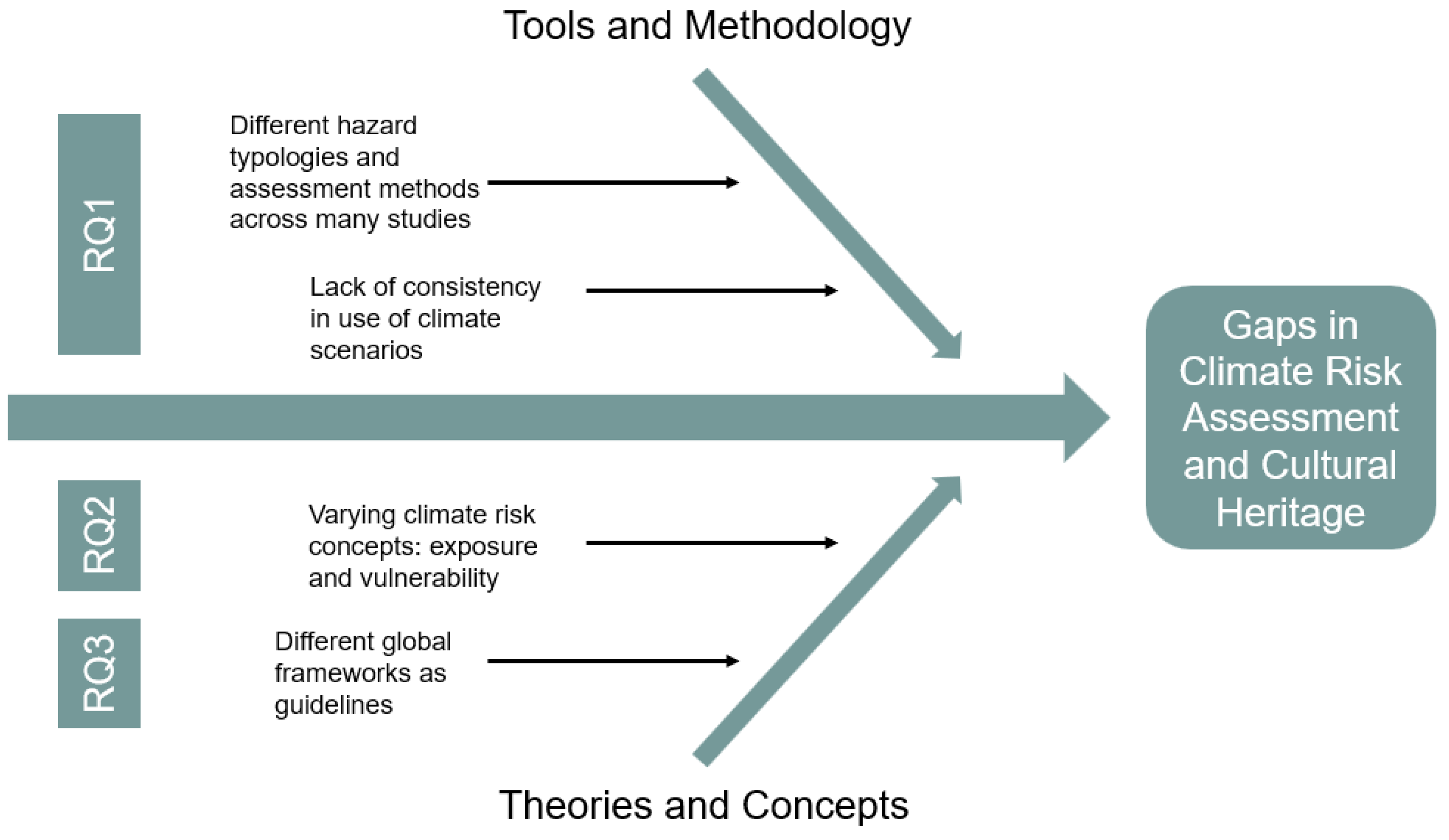
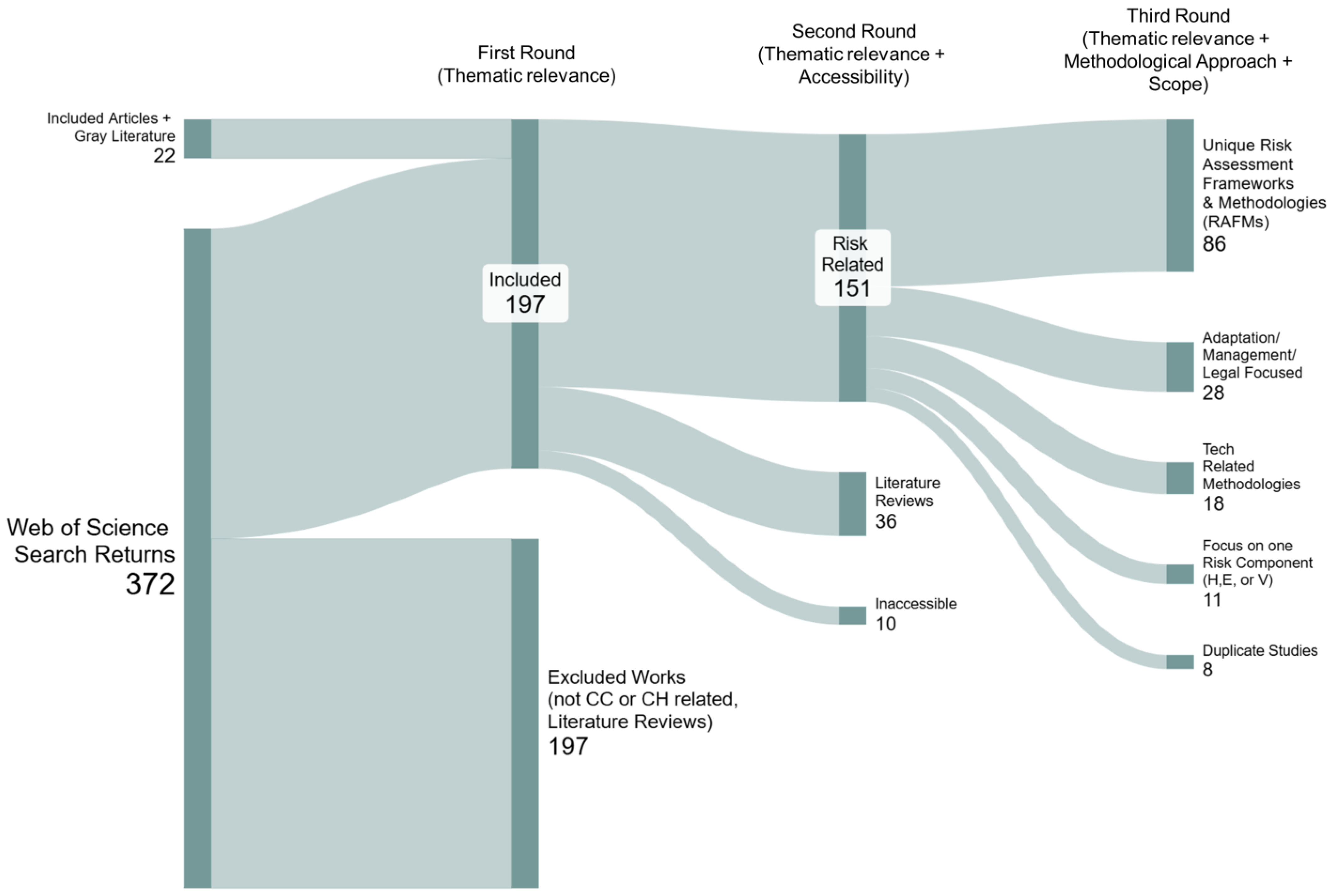
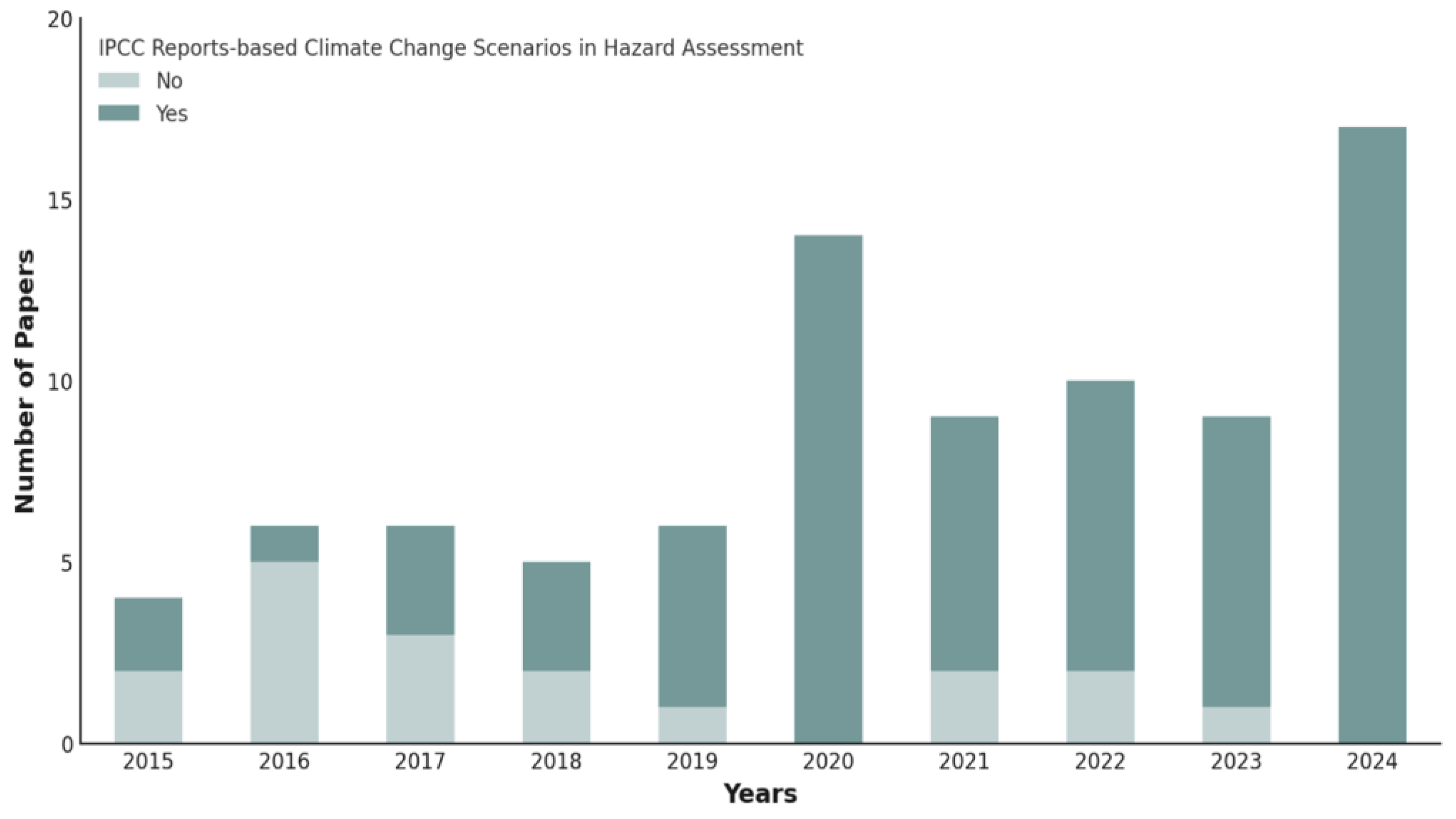
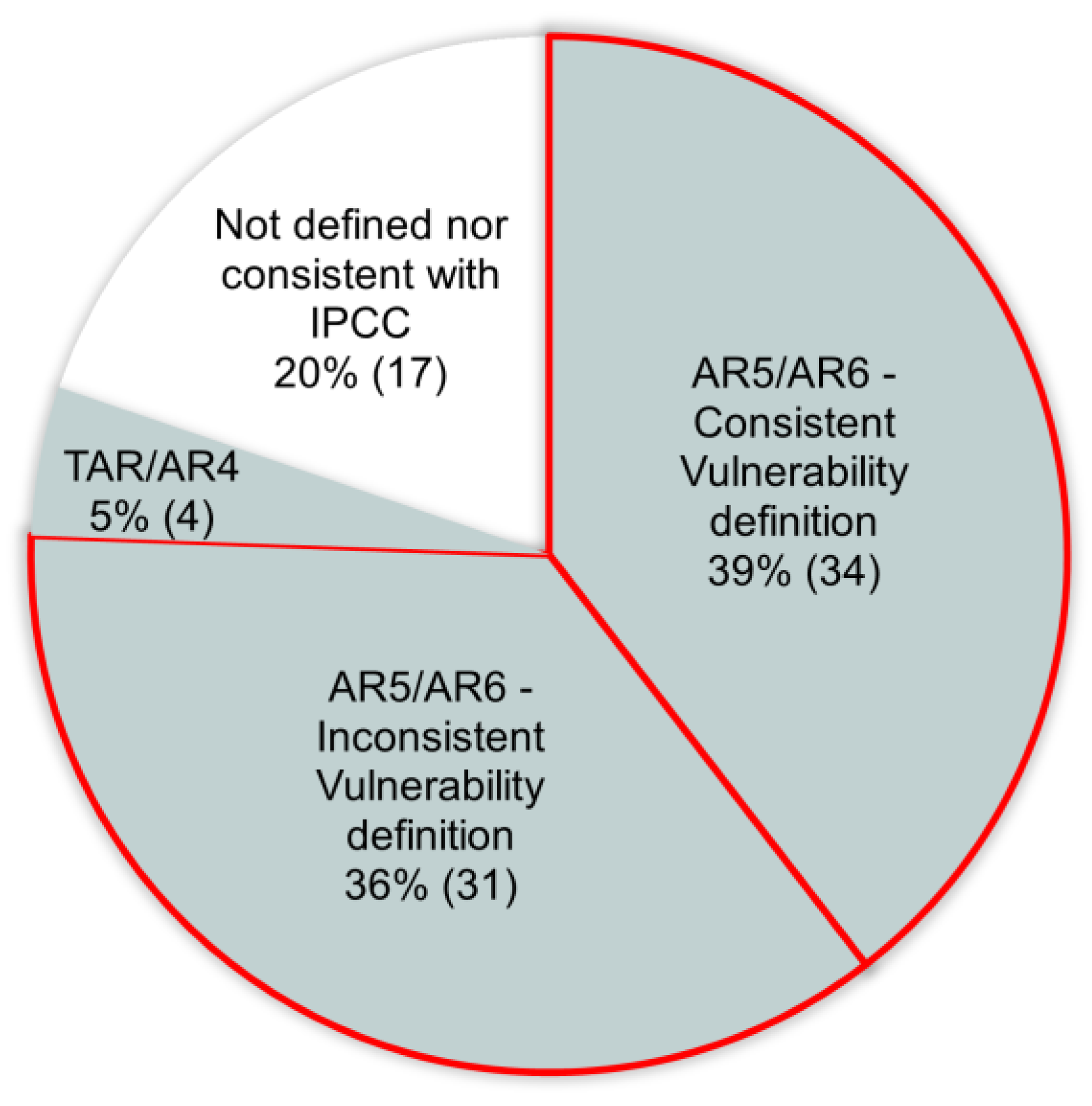
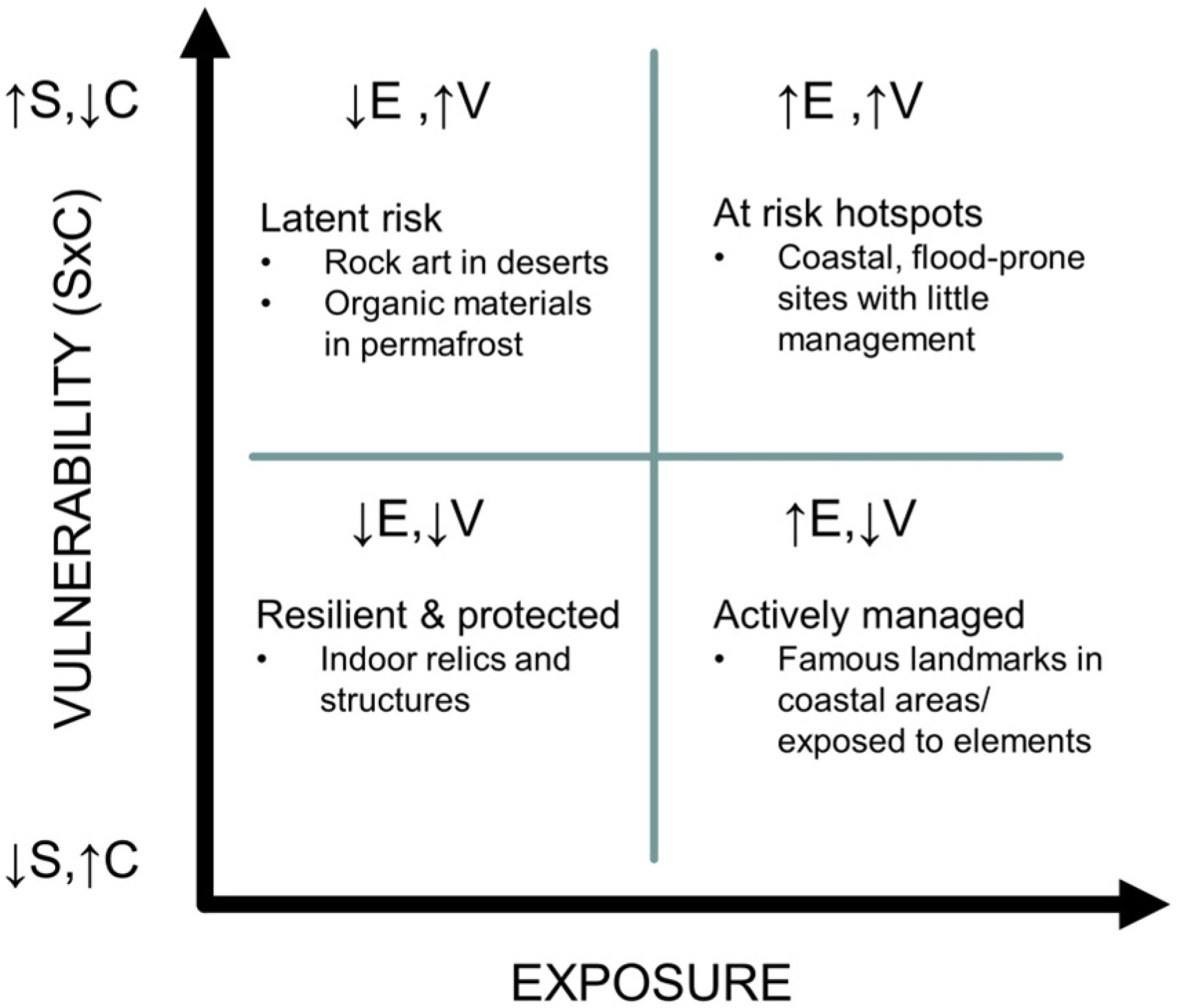
| Research Question | Context | Follow-Up Question(s) | Relevance |
|---|---|---|---|
|
|
|
|
|
|
|
|
|
|
|
|
| Objective | Scope (Years) | Number of Papers | Method | Focus Areas | Key Findings | Gaps Identified | Policy Relevance | Recommendations for Future Research | |
|---|---|---|---|---|---|---|---|---|---|
| [3] | Investigates climate change threats to cultural heritage and resources | 1900–2015 | 124 | Systematic literature review using Web of Science | Geographical scope, methodologies, barriers | CH research is increasing but remains Eurocentric | Limited focus on adaptation implementation | Suggests policy improvements for CH adaptation | Interdisciplinary research and integration of local community values in conservation planning |
| [33] | Uses machine learning for disaster risk analysis in CH | 1988-–020 | 565 | Machine-human coupled analysis | Topic modeling and classification of disaster risks | Lack of interdisciplinary collaboration in CH risk studies | Low interdisciplinarity, lack of spatially explicit studies | Highlights the importance of spatial risk assessments | Foster interdisciplinary CH risk studies |
| [35] | Conducts a scientometric analysis of CC impacts on cultural and natural heritage | 1999–2020 | 78 | Systematic literature review using Scopus and Web of Science | Trends in scientific production, citation impact, research clusters, co-authorship networks | Found research to be in early stages with limited geographic diversity; lack of standardization in risk assessments | Limited integration of climate change policy frameworks in CH risk assessments | Emphasizes the need for better integration of adaptation strategies into CH risk assessments | Results can be a good basis for future research on the same topic |
| [30] | Systematically reviews 165 publications on CH and climate change (2016–2020) | 2016–2020 | 165 | Systematic review using Web of Science | Physical impacts, adaptation, policy integration | CH research is growing but remains methodologically fragmented | Weak international collaboration and a vague approach to CC processes and timescales | Urges stronger CH inclusion in adaptation policies | Further work to understand CC and its impact on the policy and practice in CH management |
| [36] | Synthesizes climate change impacts on tangible CH | 1999–2020 | 100 | Keyword-based search from ScienceDirect and Google Scholar | Material degradation, disaster events, long-term threats | CH degradation is accelerating due to climate extremes | Need for integrated CH conservation strategies | Links CH degradation to climate policies | Further research in other regions, estimating CC uncertainties and best practices |
| [11] | Identifies gaps in CH risk assessments | 2005–2020 | 32 | Qualitative thematic synthesis using Scopus and NVivo software | Community engagement, vulnerability, resilience | CH risk assessments lack community involvement | Minimal engagement with local communities | Proposes community-driven CH risk assessments | Policy-driver research; include local knowledge in CH risk planning |
| [31] | Assesses climate risks, vulnerability, and adaptation in CH | 2016–2020 | 167 CH papers (and other non-CH works) | Global assessment and regional analysis | Includes natural heritage and global and regional risk assessments | CH impacts are underestimated in IPCC frameworks | Systematic underrepresentation in climate risk studies | Calls for CH inclusion in IPCC risk frameworks | Integrate heritage into IPCC, develop new modalities to assess CC impacts on heritage |
| [37] | Reviews frameworks for climate risk management (CRM) in CH | 2017–2021 | 165 | Two-phase systematic review using Scopus and Google Scholar | CRM adoption, quantitative vs. qualitative methods | CRM tools are underutilized at the asset level | Limited place-based assessment in CRM frameworks | Recommends multi-sectoral CRM approaches | Strengthen CRM tools for CH preservation |
| [32] | Strategic review of climate change impacts on CH | 2015–2022 | 688 | PRISMA-based review using Scopus, with international (non-English) coverage | Policy integration, research trends | CH literature is expanding but underrepresents intangible heritage | Policy-research gap, weak integration of CH in climate policies | Identifies policy gaps in CH climate change mitigation | Expand CH research in economic and social impacts, including non-Western contexts |
| [38] | Examines climate change impacts on UNESCO WH cultural properties (2008–2021) | 2008–2021 | 58 | PRISMA-based review using Scopus and Google Scholar | Hazard characterization, adaptation, UNESCO policies | CH studies focus on Europe/N. America; adaptation barriers exist | Lack of global south representation, weak policy linkages | Links UNESCO policies with climate adaptation | Enhance global collaboration, integrate CH in CC policy |
| [34] | Analyzes AI and IoT integration in CH preservation | 2015–2024 | 92 | PRISMA guidelines, Scopus database | Artificial Intelligence (AI) and Internet of Things (IoT) applications in CH risk management | IoT enables real-time monitoring, but adoption is uneven | Uneven adoption of AI/IoT in CH risk management | Encourages tech-driven CH conservation policies | Increase adoption of AI/IoT in CH conservation |
| Level of Risk Assessment | Approach | Data Prerequisites | Methodologies | Data Output | Examples of Publications That Present RAFMs with Varying Scope and Methodologies | |||
|---|---|---|---|---|---|---|---|---|
| Level 1 Global/ Regional Assessment |
|
|
|
| Level 1: [94,95] | Levels 1 and 2: [39,46,74,96] | Levels 1, 2, and 3: [70] | |
| Level 2 Regional/ Local Assessment |
|
|
|
| Level 2: [40,62,68,71,72,73,75,87,97] | Levels 2 and 3: [98,99] | ||
| Level 3 Site-specific/Heritage Asset-based Assessment |
|
|
|
| Level 3: [100,101] | |||
Disclaimer/Publisher’s Note: The statements, opinions and data contained in all publications are solely those of the individual author(s) and contributor(s) and not of MDPI and/or the editor(s). MDPI and/or the editor(s) disclaim responsibility for any injury to people or property resulting from any ideas, methods, instructions or products referred to in the content. |
© 2025 by the authors. Licensee MDPI, Basel, Switzerland. This article is an open access article distributed under the terms and conditions of the Creative Commons Attribution (CC BY) license (https://creativecommons.org/licenses/by/4.0/).
Share and Cite
Dimabayao, J.J.; Lara, J.L.; Canoura, L.G.; Solheim, S. Integrating Climate Risk in Cultural Heritage: A Critical Review of Assessment Frameworks. Heritage 2025, 8, 312. https://doi.org/10.3390/heritage8080312
Dimabayao JJ, Lara JL, Canoura LG, Solheim S. Integrating Climate Risk in Cultural Heritage: A Critical Review of Assessment Frameworks. Heritage. 2025; 8(8):312. https://doi.org/10.3390/heritage8080312
Chicago/Turabian StyleDimabayao, Julius John, Javier L. Lara, Laro González Canoura, and Steinar Solheim. 2025. "Integrating Climate Risk in Cultural Heritage: A Critical Review of Assessment Frameworks" Heritage 8, no. 8: 312. https://doi.org/10.3390/heritage8080312
APA StyleDimabayao, J. J., Lara, J. L., Canoura, L. G., & Solheim, S. (2025). Integrating Climate Risk in Cultural Heritage: A Critical Review of Assessment Frameworks. Heritage, 8(8), 312. https://doi.org/10.3390/heritage8080312









